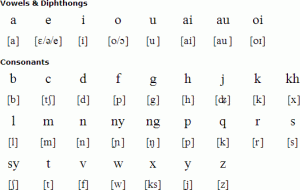Bahasa Indonesia is the national language of Indonesia. The language is classified as Austronesian language and also the standardized from of Malay language. Bahasa Indonesia is spoken throughout the country and united more than 245 millions of people in Indonesia, whose native language may be one of the over 300 regional language or dialects.
According to studies, around 30 million of people in Indonesia speak bahasa Indonesia as the first language while more than 140 millions speak bahasa as the second language. Figure out how many languages are spoken in Indonesia.
The origin of the language
Indonesian writing system was first introduced by Charles Adriaan van Ophuijsen in 1902. The writing system was later named as van Ophuijsen system and become the standardized of writing and Romanization spelling of bahasa Indonesia. The spelling and writing system was then changed into Soewandi or Republican system in 1947.
Some of the Dutch spelling and writing system was changed such as oe to u. The spelling changes also influenced the writing system such as reduplicated word. The final changes made in spelling and writing system was named the perfected spelling system or Ejaan yang Disempurnakan in 1972. Learn more about Indonesian pronunciation guide.
Indonesian Alphabets system
 Many people recognize Bahasa Indonesia as an easy language to learn. This is because Bahasa Indonesia uses Latin script or rumi which is also used in English and other languages.
Many people recognize Bahasa Indonesia as an easy language to learn. This is because Bahasa Indonesia uses Latin script or rumi which is also used in English and other languages.
In addition, Bahasa Indonesia is a phonetic language in nature. This means the alphabets are written as the way it is spoken with only few exceptions.
Learn more about what is the Indonesian alphabets.
The writing system
Bahasa Indonesia is very different from English. The influence of Javanese is very strong, that is why the language has different tones for different audiences and situation. For example the use of second person ‘you’ usually is replaced with other references unless both speaker and audience know each other well.
Another thing about Bahasa Indonesia writing system is the language almost has no tenses. The language uses time indicators such as yesterday, tomorrow, tonight, and so on in the sentence to indicate the time being spoken. There is also no grammar for gender differences and cases followed nouns. For indicating plurals, you only need to repeat the noun such as piring-piring (means more than one piring or plates).
The sentence structure in bahasa Indonesia is also similar to English with patter subject + verb + object. In bahasa Indonesia, some words usually followed with prefix, suffix, and infix to produce a complete different meaning.
For example the word masak means cooking, but masakan (masak+ suffix an) means meal, masak-masakan (repetition of masak and suffix –an for the last word means to play cooking). See, one word with prefix, suffix, infix, or repetition may have different meaning. Learn more about types of Indonesian verb prefixes phonology.
The writing system of bahasa Indonesia is fairly simple with no genders, complicated tenses, and also grammatical rules. Both writing and spelling system of the language makes foreign people consider is Indonesian as easy language to learn.
